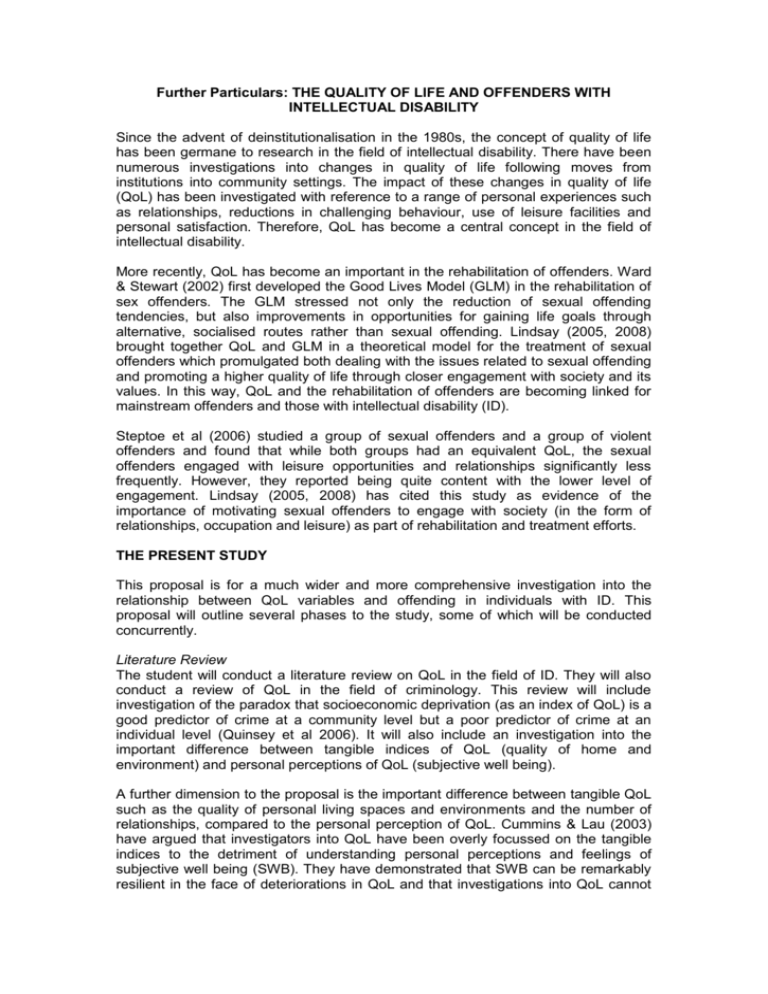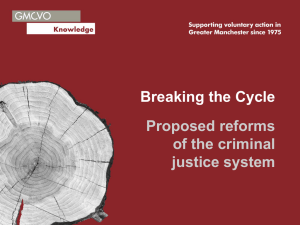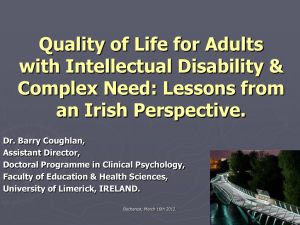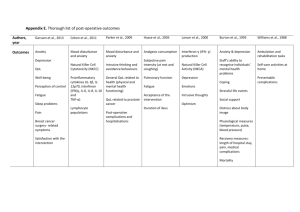
Further Particulars: THE QUALITY OF LIFE AND OFFENDERS WITH
INTELLECTUAL DISABILITY
Since the advent of deinstitutionalisation in the 1980s, the concept of quality of life
has been germane to research in the field of intellectual disability. There have been
numerous investigations into changes in quality of life following moves from
institutions into community settings. The impact of these changes in quality of life
(QoL) has been investigated with reference to a range of personal experiences such
as relationships, reductions in challenging behaviour, use of leisure facilities and
personal satisfaction. Therefore, QoL has become a central concept in the field of
intellectual disability.
More recently, QoL has become an important in the rehabilitation of offenders. Ward
& Stewart (2002) first developed the Good Lives Model (GLM) in the rehabilitation of
sex offenders. The GLM stressed not only the reduction of sexual offending
tendencies, but also improvements in opportunities for gaining life goals through
alternative, socialised routes rather than sexual offending. Lindsay (2005, 2008)
brought together QoL and GLM in a theoretical model for the treatment of sexual
offenders which promulgated both dealing with the issues related to sexual offending
and promoting a higher quality of life through closer engagement with society and its
values. In this way, QoL and the rehabilitation of offenders are becoming linked for
mainstream offenders and those with intellectual disability (ID).
Steptoe et al (2006) studied a group of sexual offenders and a group of violent
offenders and found that while both groups had an equivalent QoL, the sexual
offenders engaged with leisure opportunities and relationships significantly less
frequently. However, they reported being quite content with the lower level of
engagement. Lindsay (2005, 2008) has cited this study as evidence of the
importance of motivating sexual offenders to engage with society (in the form of
relationships, occupation and leisure) as part of rehabilitation and treatment efforts.
THE PRESENT STUDY
This proposal is for a much wider and more comprehensive investigation into the
relationship between QoL variables and offending in individuals with ID. This
proposal will outline several phases to the study, some of which will be conducted
concurrently.
Literature Review
The student will conduct a literature review on QoL in the field of ID. They will also
conduct a review of QoL in the field of criminology. This review will include
investigation of the paradox that socioeconomic deprivation (as an index of QoL) is a
good predictor of crime at a community level but a poor predictor of crime at an
individual level (Quinsey et al 2006). It will also include an investigation into the
important difference between tangible indices of QoL (quality of home and
environment) and personal perceptions of QoL (subjective well being).
A further dimension to the proposal is the important difference between tangible QoL
such as the quality of personal living spaces and environments and the number of
relationships, compared to the personal perception of QoL. Cummins & Lau (2003)
have argued that investigators into QoL have been overly focussed on the tangible
indices to the detriment of understanding personal perceptions and feelings of
subjective well being (SWB). They have demonstrated that SWB can be remarkably
resilient in the face of deteriorations in QoL and that investigations into QoL cannot
be complete without an understanding of SWB. This will be an important section in
the current proposal.
A Secondary Interrogation of an Extensive Database on Offenders with ID
Lindsay & Carson have carried out an extensive investigation into 477 offenders with
ID from a range of community and secure settings. A large number of variables have
been employed in this study, some of which are indications of QoL. These variables
include deprivation in childhood, sexual abuse in childhood, non accidental injury in
childhood, occupation at the time of the index offence and residence at the time of
the index offence. We propose that in order to have an early experience of
investigating a data set, the student should conduct a series of secondary analyses
relating these indices of QoL to security and service level, type of offence, mental
disorders in adulthood, progress through management and rehabilitation systems
over a period of two years, number of offences and other developmental
experiences. All of these variables (and several others) have been conducted as part
of the investigation (“The Pathways Project”). Ethical approval has already been
obtained for interrogation of this data set.
Studies of QoL and Offenders with ID
Steptoe et al (2006) is the only existing piece of research on QoL and offenders with
ID. If this variable is important and has a relationship to both offending and the
rehabilitation of offenders (both of these relationships are supported theoretically)
then it is important to develop this work. Offenders with ID have become a much
more important group since the implementation of deinstitutionalisation. Now there is
no longer the option of detention in a large institution and such individuals are
managed in the community on treatment or probation orders, sent to prisons or
managed in other less restrictive ways. The concept of treatment, management and
rehabilitation is now crucial, not only to policy makers and service managers (who
wish a solution to a difficult problem) but also to individual practitioners and
researchers. At the very least, the study by Steptoe et al (2006) requires replication
but there are a number of extensions to this study which would be important to the
field. For example, there are a number of individuals with ID who have similar QoL
and developmental experiences but do not go onto offend either sexually or
aggressively. It may be that certain aspects of SWB or engagement with society
would account for the differences in criminal career (or lack of…). This work can be
done both qualitatively (revealing the important variables in developmental
experiences) and quantitatively (comparing groups of offenders and non offenders
with similar backgrounds).
Studies on Subjective Well Being (SWB)
It has been a clinical observation (qualitative) by Lindsay that after being
apprehended for a crime and prior to being sentenced, there seems to be a
catastrophic drop in SWB for individual offenders. This has been shown over
repeated assessments (around 50) and is evidenced by both a temporary rise in
reports of depressive symptoms and specific assessments of SWB. This catastrophic
drop has been termed “Homeostatic Defeat” by Cummins & Lau (2004, 5). As part of
the current proposal we would like to investigate the concept of homeostatic defeat
both qualitatively and quantitatively. There are a number of concatenated studies that
can be conducted on this topic that would be important for both understanding the
current predicament of offenders with ID and their future rehabilitation.
Firstly we would like to know the extent of the homeostatic defeat when compared to
a matched group of individuals who have not committed crime, have not been
apprehended and are not due to be sentenced. It would also be interesting to
compare the reports of offenders about to be sentenced with their retrospective
perception of SWB prior to committing the offence and being apprehended.
Secondly, Cummins & Lau (2003) have demonstrated that catastrophic drops in
SWB are not permanent and that self reports return to pre event levels even when
there are no obvious improvements in QoL. We wish to investigate this phenomenon
with offenders with ID. One of the important aspects of the study would be to identify
ways in which these catastrophic drops in SWB can be captured to be used as
motivation for subsequent rehabilitation and treatment programmes. This treatment
process can be caricatured as follows:
Therapist to Offender “Look how bad you felt when you were waiting to be
sentenced. If you don’t want to feel like that again then you have to improve in the
following ways”.
While this is a simple caricature, it would be immensely important to social and health
services if we could develop methods of capturing the feelings experienced during
periods of homeostatic defeat so that they can be employed extensively during
subsequent treatment programmes.
Thirdly, from the reports of some offenders with ID, it would seem that these drops in
SWB continue and are related to continued restrictions on their lives following
sentencing. We propose to investigate the relationship between any lowering in
SWB, frustration at the continuing restrictions and subsequent offending incidents.
CONCLUSIONS
We have outlined a series of fields in which the candidate will investigate the
relationship between QoL, SWB and offending in men with ID. This has become an
important area in both general criminology and in the general research on people
with ID. No doubt, a number of further investigations will emerge as the project
unfolds. Even this were not to happen, there is ample scope in the areas already
outlined for the completion of the studies and the thesis. In our previous research we
have had access to large numbers of offenders with ID and the research student will
have similar access to participants.
Bill Lindsay
Derek Carson
Cummins, R.A., & Lau, A.L.D. (2003). The motivation to maintain subjective wellbeing: A homeostatic model. In H.N. Switzky (Ed.), Personality and
motivational systems in mental retardation. A volume in international review
of research in mental retardation. San Diego, CA: Elsevier Academic Press.
Lindsay, W.R. (2005). Model underpinning treatment for sex offenders with mild
intellectual disability: Current theories of sex offending. Mental
Retardation,43, 428-441.
Lindsay, W.R. (2009) The Treatment of Sex Offenders with Developmental
Disabilities: a practice workbook. Chichester. Wiley-Blackwell.
Quinsey, V.L., Harris, G.T., Rice, M.E., & Cormier, C.A. (2005). Violent offenders,
appraising and managing risk: Second edition. Washington DC: American
Psychological Association.
Steptoe, L., Lindsay, W.R., Forrest, D., & Power, M. (2006). Quality of life and
relationships in sex offenders with intellectual disability. Journal of Intellectual
& Developmental Disabilities, 31, 13-19.
Ward, T., & Stewart, C.A. (2003). The treatment of sex offenders: Risk management
and good lives. Professional Psychology, Research & Practice, 34, 353-360.






